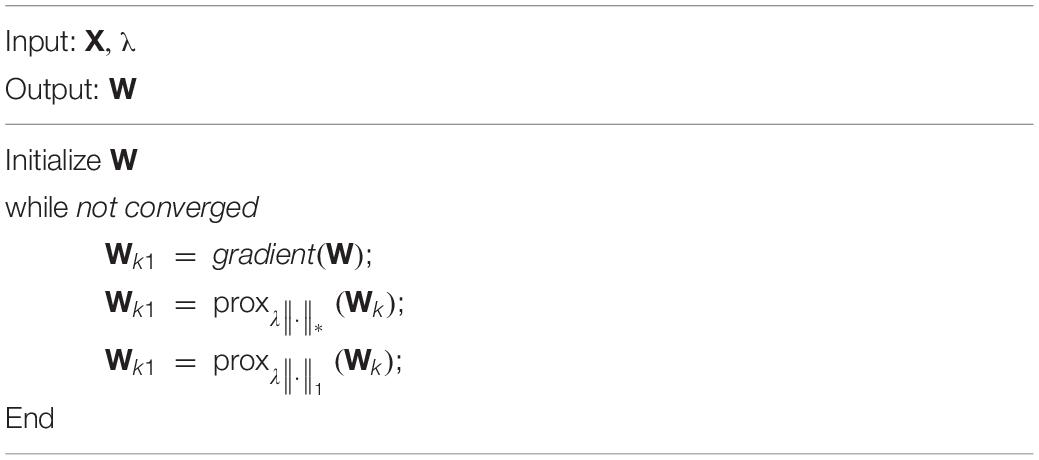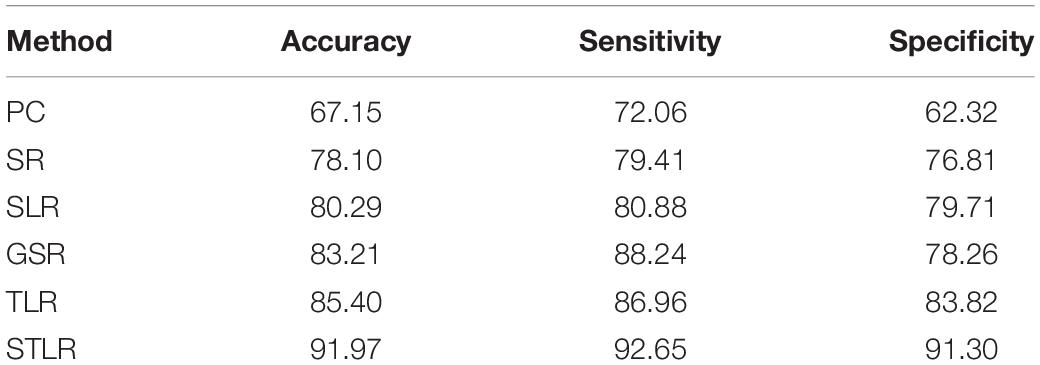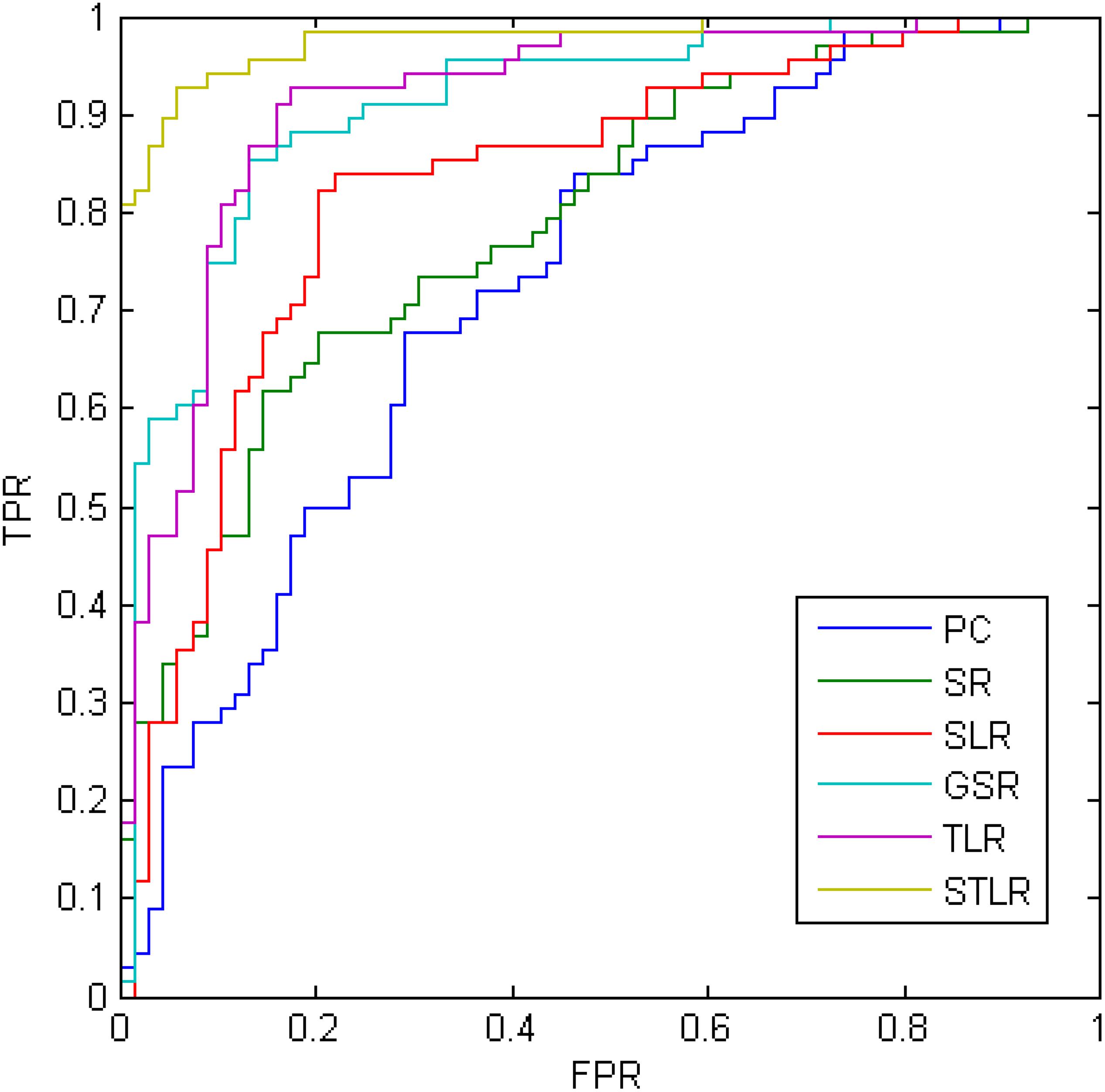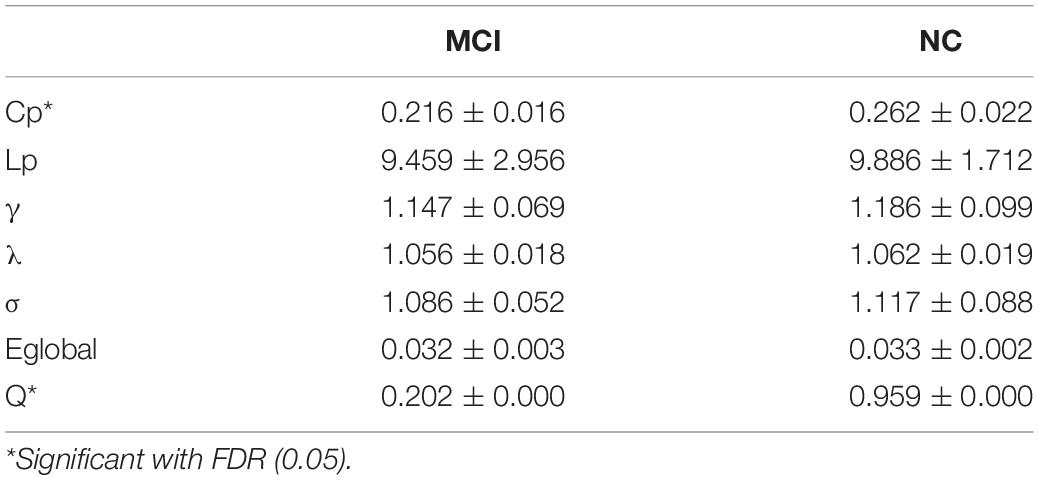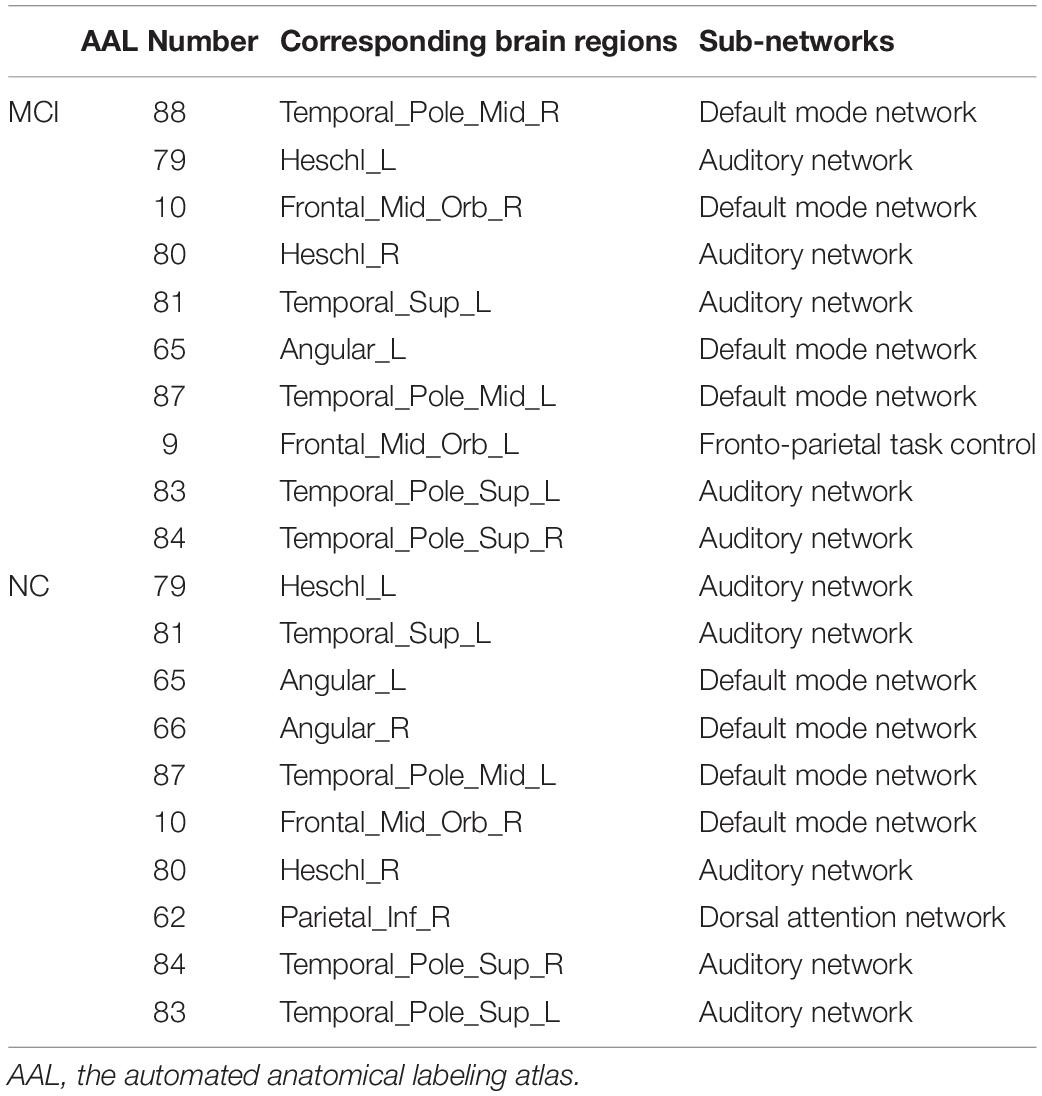- 1Shanghai Universal Medical Imaging Diagnostic Center, Shanghai, China
- 2Tongji University School of Medicine, Tongji University, Shanghai, China
- 3Department of Medical Imaging, Tongji Hospital, Shanghai, China
- 4Yueyang Hospital of Integrated Chinese and Western Medicine, Shanghai, China
- 5Shanghai University of Traditional Chinese Medicine, Shanghai, China
- 6College of Computer Science and Technology, Nanjing University of Aeronautics and Astronautics, Nanjing, China
- 7School of Mechanical and Precision Instrument Engineering, Xi’an University of Technology, Xi’an, China
Functional brain network (FBN) provides an effective biomarker for understanding brain activation patterns and a diagnostic criterion for neurodegenerative diseases detections. Unfortunately, it remains challenges to estimate the biologically meaningful or discriminative FBNs accurately, because of the poor quality of functional magnetic resonance imaging data or our limited understanding of human brain. In this study, a novel FBN estimation model based on group similarity prior was proposed. In particular, we extended the FBN estimation model to tensor form and incorporated the tensor trace-norm regularizer to formulate the group similarity constraint. To verify the proposed method, we conducted experiments on identifying mild cognitive impairments (MCIs) from normal controls (NCs) based on the estimated FBNs. Experimental results illustrated that our method is effective in modeling FBNs. Consequently, we achieved 91.97% classification accuracy, outperforming the state-of-the-art methods. The post hoc analysis further demonstrated that more biologically meaningful functional brain connections were obtained using our proposed method.
Introduction
As a neurodegenerative disorder, Alzheimer’s disease (AD) is one of the most common causes of dementia (Wee et al., 2012). According to a recent report (Bain et al., 2008), the incidence of AD doublets every 5 years after age 60. AD seriously interferes with patients’ daily life, affects their memory and ability to communicate, and eventually causes their deaths. Unfortunately, there is no effective treatment for AD thus far. Hence, it is quite important to delay the onset and progression of AD during its early stages via pharmacological and behavioral interventions.
Mild cognitive impairment (MCI) is often considered as a critical time window and treatment period for the prediction or delaying the conversion in AD (Wee et al., 2012). In some recent statistical studies, nearly 10–15% patients with MCI develop probable AD each year (Grundman et al., 2004; Misra et al., 2009). The early detection and accurate diagnosis of MCI is considered a significant means of slowing AD progression (Alzheimer’s Association, 2017).
As a successful non-invasive technique, functional magnetic resonance imaging (fMRI) provides an effective method of measurement for revealing brain activities and patterns (Brunetti et al., 2006; Kevin et al., 2008; Jin et al., 2010). However, because spontaneous brain activity is random and asynchronous across subjects and scanners, it remains a challenge to identify MCI patients from normal controls (NC) by directly using the imaging information. Furthermore, high-order FBN-based statistical information provides new perspectives for discovering brain activity and connection patterns, thus improving our ability to understand brain information (Smith et al., 2011; Sporns, 2011; Wee et al., 2012; Stam, 2014; Rosa et al., 2015). In addition, various research has shown that the changing of functional brain networks are closely related to various neurological and psychological diseases such as AD (Supekar et al., 2008; Huang et al., 2009; Liu F. et al., 2012), MCI (Fan and Browndyke, 2010; Wee et al., 2012, 2014; Yu et al., 2016), autism spectrum disorder (ASD) (Theije et al., 2011; Gotts et al., 2012), Parkinson’s disease (PD) (Baggio et al., 2014), etc. All of these depend heavily on the quality of the final estimated FBN. Hence, improved FBN reliability is crucial to such estimates (Li et al., 2019a).
According to a FBN research review (Smith et al., 2011), correlation-based methods such as Pearson’s correlation (PC) (Li et al., 2017) and sparse representation (SR) (Lee et al., 2011; Zhou et al., 2014), are generally more sensitive than complex, high-order methods. However, due to the influence of noise in the observed data, correlation-based brain networks inevitably exhibit dense connections and thus contain substantial noise or false connections. One solution is to introduce sparse priors, as is done in the thresholding and SR (LASSO) methods. Actually, the topological structure of an FBN involves more than just sparsity (Sporns, 2011). Several studies (Lee et al., 2011; Qiao et al., 2016; Wee et al., 2016; Yu et al., 2016; Li et al., 2017, 2019b) have been focused on incorporating additional biological priors into FBNs to make them more discriminative. In practice, sparsity, modularity, group-sparsity, low-rank, and scale-free priors are commonly used (Lee et al., 2011; Qiao et al., 2016; Wee et al., 2016; Yu et al., 2016; Li et al., 2017). Moreover, priors can also be obtained from data quality (Li et al., 2019a) and other high-quality data (Li et al., 2019b). Note that most of the biological/data priors can be formulated into a regularized framework. This illustrates that a reliable FBN estimation model should both fit the data well and effectively encode brain organization priors (Qiao et al., 2016).
Despite the advantages of existing FBN estimation methods, it is currently still an open field to estimate FBNs due to the complex of human brains and the poor quality of the observed data. In this paper, we focus on the group similarity prior of FBN (Wee et al., 2014), as shown in Figure 1A. In contrast, most current FBN estimation methods focus primarily on a single participant and rarely consider inter-group information from cross-participants, which result in different network topological structures across subjects. This performance inevitably makes comparisons between subjects difficult and thus can degrade the generalization performance of trained classifiers. Besides, the existing group constraint methods are mainly based primarily on the group sparsity penalty (i.e., l2,1-norm) to mitigate inter-subject variability (Wee et al., 2014; Yu et al., 2016). However, the specific information from individuals can be ignored, due to the additional l2,1-norm can often over-penalized or under-penalized connections of estimated FBN as shown in Figure 1B. In addition, some researchers have focused on group-fused multiple graphical-lasso schemes (Liang et al., 2016, 2018), which alleviating the issue of group sparsity constraints in some extent. As mentioned above, existing group-based FBN estimation approaches still have great potential.

Figure 1. The motivation for the proposed tensor based FBN estimation model. (A) The estimated FBNs tend to have a group constraint. (B) The group lasso may easily lose discriminative features since it over-penalized or under-penalized connections from all subjects. In contrast, the tensor low-rank can effectively avoid this issue and thus naturally provide more discriminative connections.
In this paper, we use the regularization framework to incorporate the group similarity constraint into the FBN estimation model. In detail, we formulate the group similarity prior as a tensor low-rank (TLR) regularizer and incorporate it into the FBN estimation model. In addition, we further incorporate the sparse and tensor low-rank (STLR) for better FBN estimation. Since the low-rank is NP-hard, we optimize its upper limit (i.e., the trace norm penalization) for better calculation efficiency. In particular, we adopt Parallel factor analysis (PARAFAC) to calculate its eigenvalues (Liu X. et al., 2012) and design a proximal operator to estimate the FBN with the group similarity constraint. In the end, we incorporate the trace norm regularizer into the SR and PC models to create a simple test platform. To verify the proposed methods, we adopt an estimated FBN for MCI identification. In fact, the proposed method uses the group similarity constraints to shrink the FBN solution space, and thus can estimate more discriminative FBNs effectively. The highlights of this paper include:
1. We incorporate the group similarity constraint into the FBN estimation model using a low-rank regularizer. In addition, we further relax it into a trace norm regularizer and design an optimization algorithm to estimate FBNs with group similarity.
2. We use group similarity-based FBNs to separate MCIs from NCs. The experimental results show that the proposed scheme outperforms the baseline methods. Moreover, the proposed methods can provide more biologically meaningful connections than existing methods.
3. We provide an effective FBN estimation module useful in modeling the group similarity prior. The module is flexible enough to incorporate into other FBN estimation models. The experimental results show that the proposed module can effectively improve the MCI classification accuracies of the estimated FBNs.
4. We identified the most significant functional connections and the most discriminative brain regions using the proposed FBN estimation model. This analysis of functional connectivity and graph theory attributes can be used to discover biologically meaningful biomarkers and further elucidate the topological properties of a brain network that is experiencing MCI.
The remainder of this paper is organized as follows. In Section 2, we introduce our data preparation methodology. The proposed methods, i.e., the group similarity-based FBN estimation schemes, including the motivations, models, and algorithms are introduced. In Section 3, we evaluate the proposed methods using MCI identification experiments. A discussion and conclusions are presented in Sections 4 and 5, respectively.
Materials and Methods
Data Acquisition
For this study, we adopted publically available neuroimaging data from the Alzheimer’s Disease Neuroimaging Initiative (ADNI) database (Jack et al., 2010)1. ANDI was launched in 2003 by the National Institute on Aging, the National Institute of Biomedical Imaging and Bioengineering, the Food and Drug Administration, private pharmaceutical companies, and non-profit organizations. The initial goal of ADNI was to define biomarkers for use in clinical trials and to determine the best way to measure the treatment effects of AD therapeutics.
In particular, 137 participants including 68 MCIs and 69 NCs were adopted in this experiment, which was similar to a previous study (Zhou et al., 2018). The scanning parameters included: TR/TE = 3000/30 mm, flip angle = 80, imaging matrix = 64 × 64, 48 slices, 140 volumes, and voxel thickness = 3.3 mm. The SPM8 toolbox2 and DPARSFA (version 2.2) (Chao-Gan and Yu-Feng, 2010) were used to preprocess the fMRI data using the well-accepted pipelines. The preprocessing pipeline included removing the first 10 volumes, slice timing, realigning, normalizing, spatially smoothing, temporally detrending, regressing out covariates (ventricle and WM signals, as well as six head-motion parameters), and temporally filtering. We followed previous work (Chen et al., 2016, 2017) to alleviate head motion effects and artifacts and excluded subjects with more than 2.5 min (50 frames) of data with FD > 0.5 from further analysis (Power et al., 2012). Finally, we used the automated anatomical labeling (AAL) atlas (Tzourio-Mazoyer et al., 2002) to partition pre-processed blood-oxygen level dependent (BOLD) signals into 116 ROIs with 137 volumes. Finally, for kth participants, we put these volumes into a data matrix X(k) ∈ RN×T(X for short). For more details, please refer to Zhou et al. (2018).
Functional Brain Network Estimation
After obtaining fMRI data matrix X from the R-fMRI data, we performed FBN estimation. As mentioned above, correlation-based FBN estimation methods have been demonstrated to be more sensitive than some complex higher-order methods (Smith et al., 2011). Therefore, this paper focuses on correlation-based methods and adopts them as a baseline. In particular, we first defined the data matrix (i.e., the BOLD signal matrix) X ∈ RN×T, where T is the number of volumes and N is the number of ROIs. The fMRI time series associated with the ith ROI is represented by xi ∈ RT, i=1,⋯,N.
Correlation-Based Methods
As the simplest and most widely used FBN estimation schemes, PC-based FBN estimation methods account for a large proportion of FBN studies (Smith et al., 2013). The FBN edge weights W = (Wij) ∈ RN×N can be calculated via PC as follows:
In Eq. (1), is a centralized counterpart of xi. Due to the effects of the noise in the fMRI data, PC always generates dense FBNs. Thus, a thresholding scheme is often used to make the PC-based FBNs sparse by filtering out the noisy or weak connections. The PC based FBN can be expressed as follows:
where denotes the connection value between nodes i and j after thresholding.
When one compares PC measures to full-correlation cross ROIs, one notes that the interaction among multiple ROIs is neglected due to the cofounding effect. In contrast, a partial correlation is proposed by regressing out the confounding effects from other ROIs. However, the partial correlation-based methods can easily be ill-posed due to the singularity of the covariance matrix Σ×XTX. One simple solution is to incorporate an l1-norm regularizer into the partial correlation model (Lee et al., 2011), thus naturally incorporating the FBN sparsity prior (SR). The SR model is as follows:
The matrix form is proposed as follows:
Note that the l1-norm regularizer in Eq. (4) plays a key role in achieving a sparse, stable solution (Lee et al., 2011).
Regularization Framework for FBN Estimation
Based on the above description, both PC- and SR-based FBN estimation models can be summarized into the regularized FBN learning framework. We can naturally incorporate a regularized term and statistical information into the objective function in order to construct a new FBN estimation platform. Specifically, the platform can be formulated using a matrix-regularized learning framework as follows:
where f (X,W) models the FBN statistical information and R(W) is the regularization term used to incorporate FBN biological priors and stabilize solutions. In addition, some specific constraints such as symmetry or positive semi-definiteness may be included in △ to shrink the W search space. This provides an effective way of obtaining a better FBN. The λ is a hyper-parameter that controls the balance between the first (data-fitting) and second (regularization) terms.
Most of the recently proposed FBN estimation models (Higgins et al., 2018; Li et al., 2018; Wang et al., 2018; Zhou et al., 2018) can be unified under this regularized framework by re-designing the two terms in Eq. (5). Popular data-fitting terms include used in Eq. (2) and used in Eq. (4), while popular regularization terms include l1-norm (Huang et al., 2010), trace norm, their combination (Qiao et al., 2016), etc.
Sparse and Low-Rank-Based FBN Estimation
Before we introduce the proposed method, we would like to review the sparse and low-rank-based (SLR) FBN estimation model briefly (Qiao et al., 2016). The sparsity and low-rank regularizers, i.e., the l1-norm and trace norm) causes sparse and similar connections across each brain region, naturally incorporating estimated FBN modularity priors. The SLR FBN estimation model is given as follows:
where X is the BOLD signal data, W represents the estimated FBNs, λ||W||1 is the sparsity regularizer and γ||W||* is the low-rank regularizer.
Group Sparsity-Based FBN Estimation
However, the abovementioned FBN estimation models are unable to deal with inter-subject variability problems because the FBN is estimated at an individual level, which easily causes different network topological structures across subjects To mitigate the effects of inter-subject variability, Wee et al. proposed a group-constrained sparse linear regression model (Wee et al., 2014) that applied the idea of joint feature selection in group-lassos to regression problems (Yuan and Lin, 2006). In particular, a group sparsity regularizer (GSR, i.e., l2,1-norm) was incorporated into the FBN estimation model. The GSR FBN estimation model is given as follows:
where is the BOLD signal of the jth ROI and kth participant, Xk is the data matrix of k participants, represents the functional connections of the jth ROI and kth participant, and λ||W||2,1 is the group sparsity regularizer. Relative to the SR method, this minimizes inter-subject variability via an additional l2-norm regularizer across all subjects. However, these methods may penalize too much for estimated FBNs. For example, if a functional connection is removed from the MCIs but exists in NCs and the weight of this connection in the NCs is slightly larger than in MCIs, the GSR method tends to force removal of this connection from the NCs. In addition, if the number of NCs or the weight of this connection in the NCs is substantially larger than in the MCIs, the GSR method tends to force this connection to exist in the MCIs. Thus, a GSR can lose discriminative information from estimated FBNs, as shown in Figure 1B.
Methods
To incorporate group constraints easily and directly, we first extended the existing matrix regularization framework to tensor form as follows:
where X(k) ∈ RN×T represents the input data of the kth participant., ROI is the number of predefined ROIs, T is the duration of data observation, and n is the number of participants. W ∈ RN×N×K represents the estimated FBNs and W(k) ∈ RN×N represents the corresponding FBN of the kth participant. K is the number of participants. Obvious, in Eq. (8), W is 3-dimensional tensors. As with the matrix regularization framework, in Eq. (8), is the data-fitting term and R(W) is the regularization term in tensor format.
As shown in Figure 1, the abovementioned l2,1-norm penalty excessively punishes the estimated FBNs, which leads to interference across various groups in the data. To alleviate this issue, this paper uses the tensor regularization framework to relax the l2,1-norm penalty and naturally introduce the tensor low-rank (TLR) regularizer to formulate the group similarity prior. The proposed tensor low-rank-based FBN estimate can formulated as follows:
For the regularized terms in Eq. (9), R(W)lowrank indicates the rank of tensor W, which can be represented by number of non-zero elements in the eigenvalue of W. Unfortunately, the low-rank regularizer is non-convex with respect to W and is NP-hard to solve. Thus, we relax it to trace-norm ‖W‖* and obtain the following optimization model:
Here, we aim to capture the partial correlation of the observed fMRI data due to its empirical effectiveness. In particular, we adopted SR as a testing platform since the PC method suffers from cofounding effects. In particular, we used as the data-fitting term to formulate the inverse covariance structure (i.e., partial correlation) in the data, and added a l1-norm penalty to encode the sparse priors, resulting in the following Sparse and Tensor Low-Rank (STLR) optimization model.
where λ and γ are hyper-parameters used to control the balance between the three terms in the objective function. It should also be noted that the data fitting term can be designed as to capture full correlation statistics. In addition, when γ = 0, the proposed method reduces to the network learning model based on the traditional sparse regression FBN estimation method given in Eq. (4). As we can see in Eq. (11), when λ = 0, Eq. (8) will be reduced to TLR.
Algorithm
Because the l1-norm and trace penalties exist, the proposed scheme is convex but non-differentiable. This leads to a non-trivial problem. Fortunately, several approaches have been proposed for dealing with such issues (Donoho and Elad, 2003; Meinshausen and Bühlmann, 2006; Tomioka and Sugiyama, 2009). In this paper, we use the proximal method (Combettes and Pesquet, 2011) to solve the proposed optimal FBN estimation model because of its simplicity and efficiency. The details are given as follows:
First, we address the STLR or TLR data-fitting term (i.e., ), whose gradient with respect to Wk is . For each iteration, we first update the W according to the gradient descent criterion:
where at denotes the gradient descent step size. The initial value of the step size at was set to 0.001 and subsequently adaptively updated based on the line search scheme proposed by Nemirovski (Nesterov, 1983) using the SLEP toolbox3.
Second, we address the regularization term ||W||1. According to the definition of a proximal operator (Combettes and Pesquet, 2011), the proximal operator of ||W||1 is equivalent to the following soft thresholding operation on W,
Similarly, the proximal operator λ||W||* corresponds to a shrinkage operation on the singular values of W as follows.
Here, air, ajr, akr is a vector in unit norm space and λr is the corresponding eigenvalue based on the parallel factor analysis (PARAFAC) (Liu X. et al., 2012). Then, the final algorithm is given in Table 1:
Experiment
Experimental Setting
After obtaining the FBNs of all subjects, the main task remaining was to use the aforementioned FBNs to train a classifier that could separate ASDs from NCs. Since the FBN matrix was symmetric, we used only its upper triangular elements as classification input features. Even so, the feature dimensions remained too high to train a classifier with good generalization due to the limited training sample availability in this study. Therefore, we performed feature filtering before classification training. Specifically, the classification pipeline included the following two main steps. A flow chart is given in Figure 2. First, we estimated FBNs for each individual using PC4, SR, SLR, GSR, TLR and STLR. The estimated FBNs are shown in Figure 3. After we obtained the estimated FBNs, we sought to determine how to use these connections to separate MCIs from NCs. It should be noted that both the feature selection and classifier design have large influences on the final accuracy (Wee et al., 2014). Because of this and because our focus was FBN estimation, we adopted the simplest feature selection method (t-test with p-value < 0.01) and used the most popular linear SVM classifier with default parameter C = 1 (Chang and Lin, 2007).
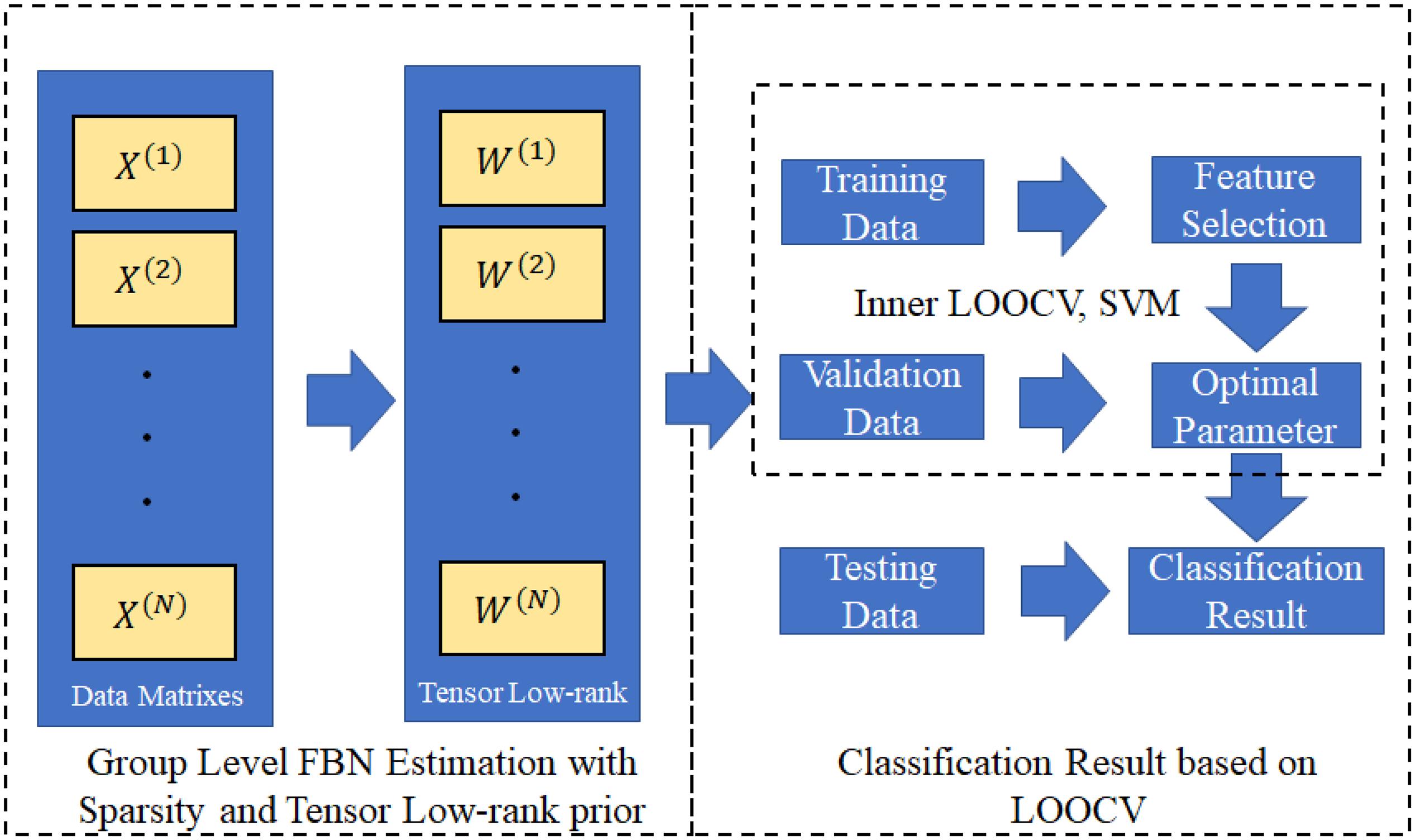
Figure 2. This flowchart shows the TLR/STLR implementation in group level FBN estimation and use of LOOCV for classification.
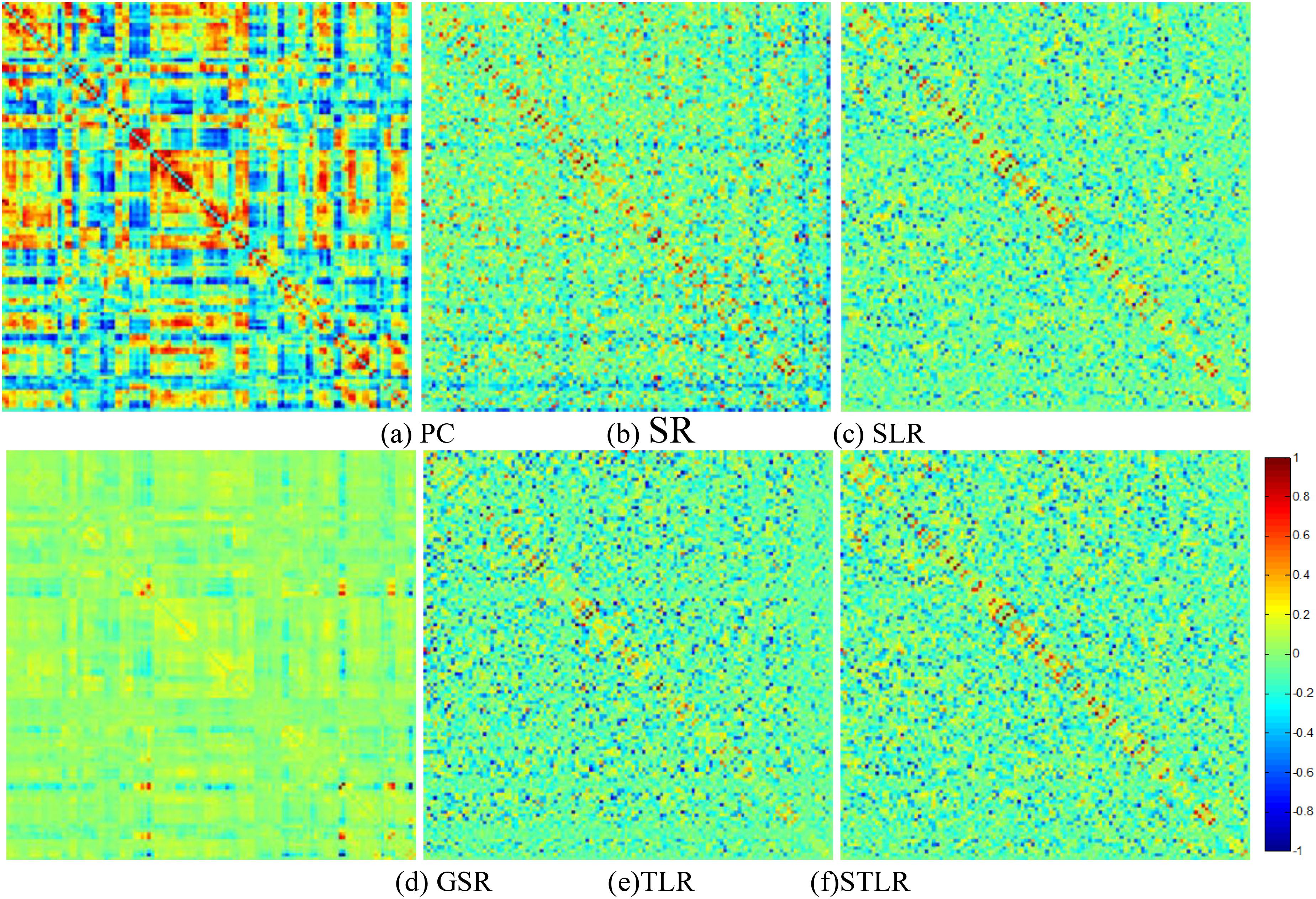
Figure 3. The FBN adjacency matrices of a certain subject, constructed by (a) PC, (b) SR, (c) SLR, (d) GSR, (e) TLR and (STLR).
Due to the small sample size, we used the leave one out cross validation (LOOCV) strategy to verify method performance. In this strategy, only one subject was left out of testing while the others were used to train the models and determine optimal parameters. To choose optimal parameters, an inner LOO cross-validation was further conducted on the training data using a grid-search strategy. In the outer loop, we chosen the training and testing dataset to re-select feature and re-train the model by the selected parameters. More specifically, for the regularized parametersλ and γ, the candidate value range was [2−5,2−4,⋯,24,25]. For the hard threshold of PCthreshold, we used 20 sparsity levels with a range of [5%, 10%,⋯,95%,100%]. For example, 90% means that 10% of the weak edges were filtered out of the FBN. In the outer loop, we used a training and testing dataset to re-select features and re-train the model based on the selected parameters.
Network Visualization
For visual comparison of the FBNs constructed using the PC, SR, SLR, GSR, TLR and STLR methods, we first show the FBN adjacency matrices. W is shown as constructed via various methods in Figure 3. It can be observed from Figure 3 that the PC-based FBNs (i.e., Figure 3A) are quite different from the SR-based FBNs (i.e., Figures 3B–F) since they use a different data-fitting term [i.e., the first term in Eq. (5)]. Moreover, the topology of the FBN as estimated via SLR is similar to those produced by STLR and TLR because (1) both methods employ the same data-fitting term and (2) the low-rank and sparse regularity behind SLR (i.e., the trace norm in the matrix scheme) are based on the STLR result (i.e., the trace norm in the tensor scheme).
MCI Identification
The MCI versus NC classification results from the ADNI dataset are given in Table 2. The proposed STLR method achieved the best accuracy in this experiment. In addition, the SLR and GSR results are also provided in Figure 4 and Table 2.
A set of quantitative measurements, including accuracy, sensitivity and specificity, were used to evaluate the classification performances of six different methods (PC, SR, SLR, GSR, TLR and STLR). The mathematical definitions of these three measures follow:
Here, TruePositive is the number of positive subjects that are correctly classified in the ASD identification task. Similarly, TrueNegative, FalsePostive, and FalseNegative are the quantities of their respective, corresponding subjects. In addition, the ROC of these methods is provided in Figure 4.
Sensitivity to Network Model Parameters
Regardless of the FBN estimation method used, the classification accuracy is sensitive to various parameters (e.g., regularized SLR, GSR, TLR, and STLR parameters). Therefore, in our above classification experiments, we determine classification results with various parameters based on LOOCV. In Figure 5, we show the classification accuracies that correspond to various STLR parametric combinations. Figure 5 shows that we achieve the best accuracy (92.70%) with λ = 2−3 (for sparsity) and γ = 24 (for tensor low-rank).
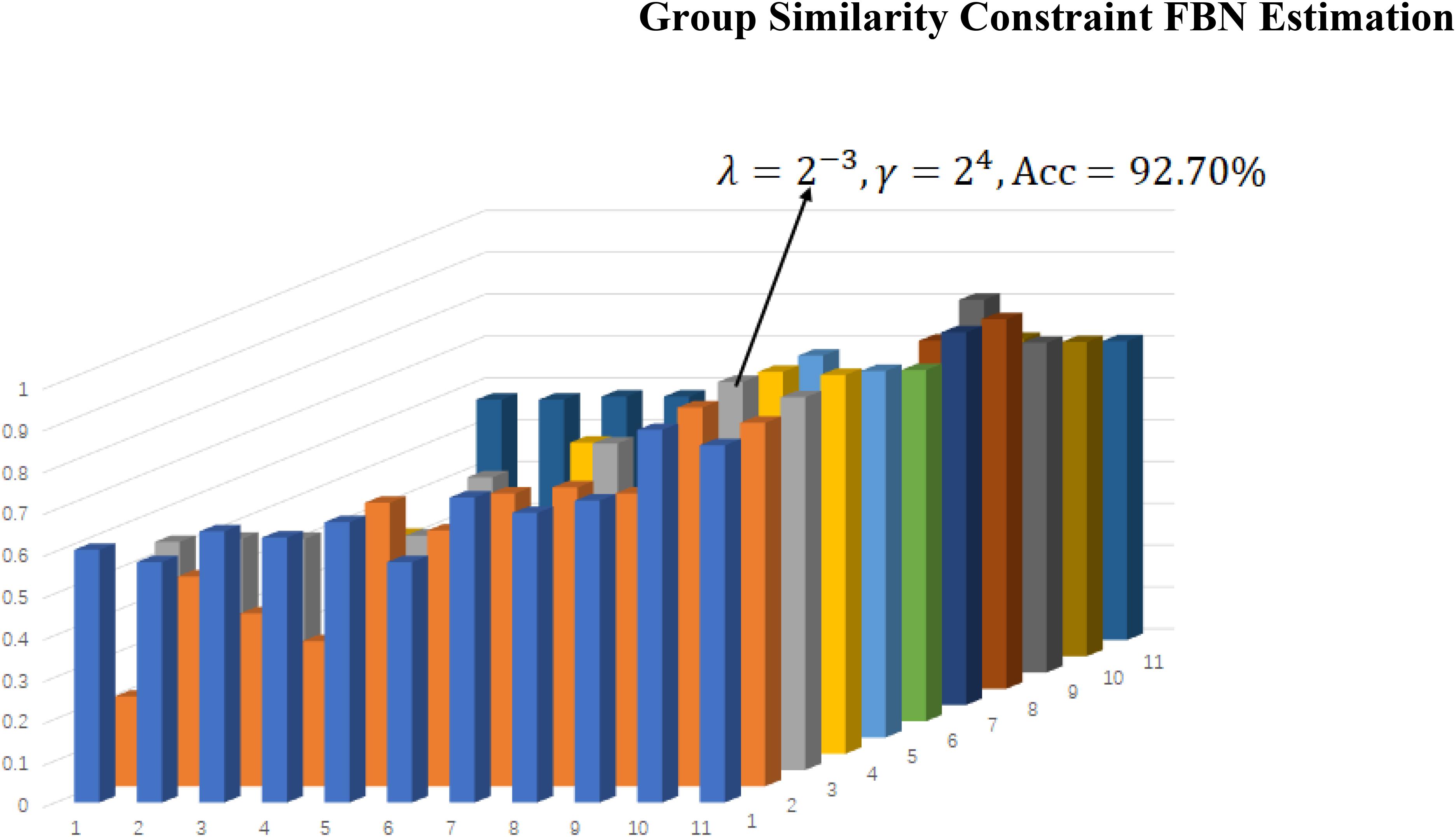
Figure 5. Classification accuracy based on the networks estimated by the proposed method with different regularized parametric values in the interval [2−5,25]. The results are obtained by LOO test on all subjects.
Most Discriminant Brain Regions and Consensus Connections
As the selected connections in each inner loop might be different. We recorded all selected features during the training process. The statistics of the selected connections include a mean of 131.08 and variance 4.15. In addition, we further record the consensus connections for the classification model in each inner LOOCV loops. As mentioned above, we select the consensus connections with p-value < 0.01 in each loops, resulting in the 82 consensus connections shown in Figure 6. The thickness of an arc indicates the discriminative power of an edge, and is inversely proportional to the estimated p-values. The arc colors in Figure 6 are randomly generated to differentiate ROIs. In particular, there are 19 functional network connections that show decreased functional connectivity in patients with MCI.
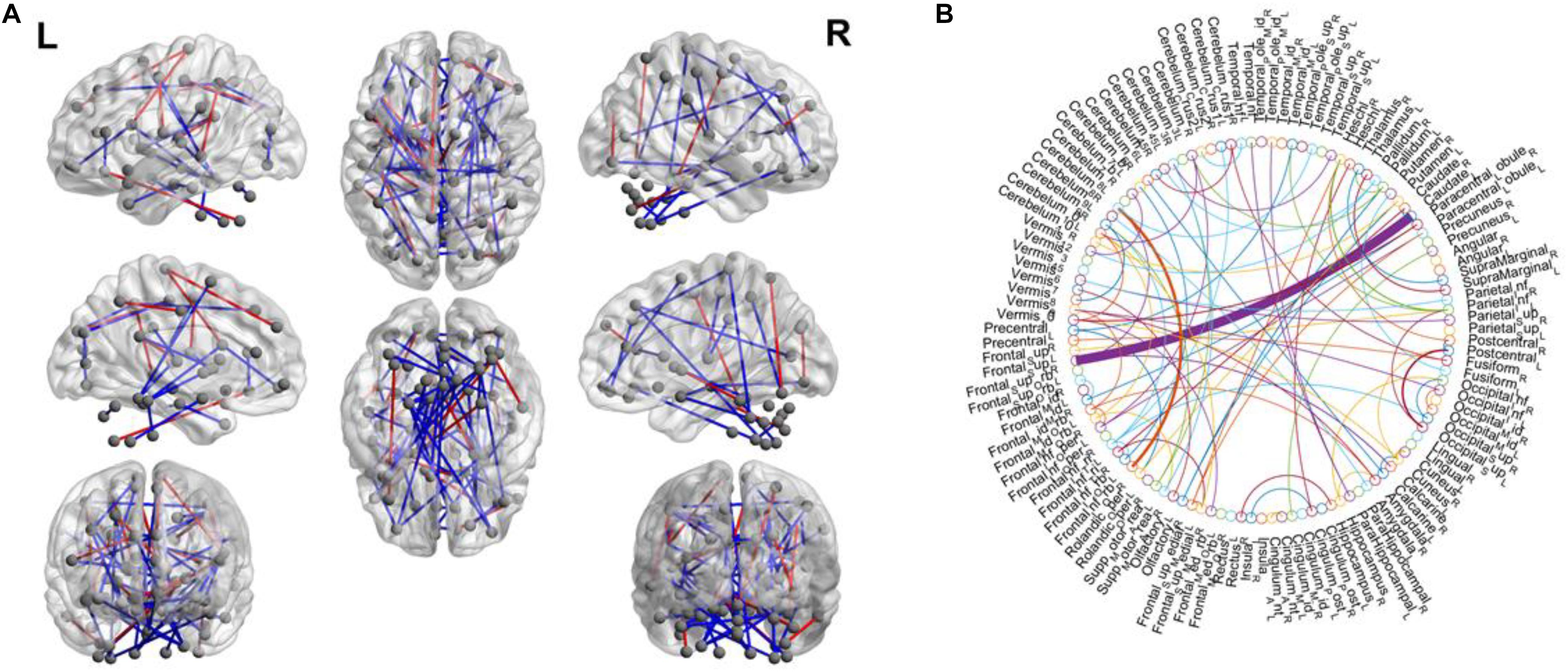
Figure 6. (A) The most significant functional connections mapped on the ICBM 152 template using the BrainNetViewer package (http://nitrc.org/projects/bnv/). The green and red lines represent connection weights that are decreased and increased in MCIs, respectively. (B) The consensus connections, selected via LOOCV, between MCI and NC for 116 AAL template ROIs. The arc thickness indicates the discriminative power of an edge, which is inversely proportional to the estimated p-values. This figure was created using a Matlab function, circularGraph, shared by Paul Kassebaum (http://www.mathworks.com/matlabcentral/fileexchange/48576-circulargraph).
In addition, we provide the most significant MCI and NC brain regions. In particular, the top 20 brain regions (without the cerebellum) with the largest number of discriminative connections (p < 0.01) are given in Table 3. The experimental results demonstrate that the brain regions that most discriminate between MCIs and NCs are distributed primarily in the thalamus, middle temporal gyrus, hippocampus, parahippocampal gyrus, inferior parietal (which corresponds to the subcortical network), Default mode network (DMN), dorsal attention network, and fronto-parietal task control network.

Table 3. The top 20 brain regions (without the cerebellum) with largest number of discriminative connections.
STLR on an Independent Dataset
To evaluate the purposed scheme further, we re-selected 50 independent participants (including 27 MCIs and 23 NCs) from the ADNI dataset to create an independent test dataset. Following the same preprocessing pipelines as mentioned above, the model was pre-trained on the aforementioned dataset with λ = 2−3 (for sparsity) and γ = 24 (for tensor low-rank). Consequently, it achieved 86.00% accuracy, 91.30% sensitivity, and 85.19% specificity, which further demonstrated the effectiveness of the proposed method.
Altered Functional Network Topological Properties in MCI Patients
Based on the FBN estimated via STLR with λ = 2−3 (for sparsity) and γ = 24 (for tensor low-rank), several global graph theory metrics, including clustering coefficients (Cp), the shortest path length (Lp), the normalized clustering coefficient (γ), the normalized characteristic path length (λ), as well as small-world (σ) and global efficiencies (Eglobal), were calculated to uncover the topological properties of functional networks in MCI and NC groups (Table 4). Moreover, we employed Modified Greedy strategy to calculate the modularity scores of the estimated FBNs (Newman, 2006). As expected, both groups fit γ = Cpreal / Cprand >1, λ = Lpreal / Lprand ≈1 and σ = γ/λ>1. Thus, the functional networks of MCI patients and NCs exhibit small-world topological attributes (Watts and Strogatz, 1998). This means that the brain networks of the two groups maintain complex, efficient neural architectures that optimize the balance between local specialization and global integration (Sporns and Zwi, 2004; Achard and Bullmore, 2007; Sporns, 2012). Further comparisons suggest that the small-world σ-values of MCI patients are lower than those of NCs, which indicates the disruption of the “economic small-world” (i.e., reductions in the effective segregation and integration of information in the brain network). Furthermore, we found the Cp-values and modularities (Q-values) in MCI patients to be significantly lower than those in NC groups (P < 0.01). These changes in Cp and modularity suggest reduced local information processing network segregation in MCI patients. Although there is no significant difference between MCIs and NCs in Lp and Eglobal, the lower values of these two global topological attributes in MCIs indicate decreased network integration.
Using the definition of “hubs” (Sporns, 2011), we identified hub nodes in MCI patients and NCs. As shown in Table 5, the common MCI and NC hub regions are located primarily in the bilateral superior temporal, bilateral heschl, right middle frontal, and left angular gyrus. Most are distributed in the DMN, auditory network, fronto-parietal task control network, and dorsal attention network. Moreover, it is notable that some hub nodes are present only in MCI patients but absent in NCs. These are the several hubs found in the right middle temporal and left middle frontal gyrus. In addition, there are some hub nodes found in HCs but not in MCI patients. They are located on the right inferior parietal and right middle frontal gyrus. These discriminative brain regions are distributed mainly in the DMN, fronto-parietal task control, and dorsal attention networks. Differences in subnetworks and corresponding brain regions play important roles in differential diagnosis of MCI relative to NC status.
Discussion
The human brain is one of the most complex systems in the world. To ensure efficient brain information interactions, the FBN should have more “structures” than sparsity (Smith et al., 2011; Sporns, 2011). In this work, we incorporated a tensor low-rank regularizer to model the group similarity priors of the estimated FBNs. The MCI versus NC classification capabilities of the proposed models were verified using the ADNI dataset. Based on the results, we give the following brief discussion.
1. STLR-based methods were more accurate than baseline and state-of-art methods on our dataset. One possible reason is that the STLR scheme naturally incorporates additional information from inter-group subjects, and thus can produce clearer or more discriminative FBNs. It should also be noted that the proposed scheme is a flexible module. In addition to using SR-based models, it can be easily adopted using other FBN estimation models such as PC-based, Bayesian, or Granger causal-based networks. Also, we can incorporate other biological group priors into the tensor-based FBN estimation models.
2. The most discriminative functional connections and the corresponding predominating brain regions were discussed. By projecting brain regions with significant brain network functional connectivity differences and graph theory metrics to subnetworks, we found that the differences between MCI patients and NCs were distributed mainly in the DMN, dorsal attention, frontoparietal task, executive control, and auditory networks. Of these, the DMN had the most significant discriminative ability. Changes in these subnetworks were consistent with the results of previous cognitive function studies such as those on spatial attention (Rolle et al., 2017), executive function (Liao et al., 2019), and auditory function (Bi et al., 2018) that reference subnetworks in MCI patients. Moreover, the DMN has been regarded as the core part of a functional center (Liu et al., 2019) that is involved in episodic memory and is thought to be the major cognitive domain impaired during early-stage AD (Eyler et al., 2019). That the DMN contains the most distinguishing information for MCI identification was verified using our proposed methods. Furthermore, in our study, we located the predominant brain regions (i.e., the thalamus, middle temporal gyrus, hippocampus, parahippocampal gyrus, and inferior parietal and middle frontal gyrus) for MCI diagnosis.
3. Brain network patterns are altered in MCI patients. Our study found that the global topological properties of MCI patients and NCs fit the small-world attribute. That is, the brain networks of MCI and NC groups conform to “economic small-world” classification, which uses rapid, real-time information processing across separate brain regions to maximize efficiency with minimal cost and to render resilience against pathological attacks (Sporns and Zwi, 2004; Sporns, 2012; Liao et al., 2017). Statistical analysis suggested that the value of small-world σ was lower in MCI patients than in NCs, which indicated disruption of brain network integration and segregation. This MCI small-world result is consistent with previous research (Yu et al., 2018). Moreover, the significantly decreased Cp and modularity values noted in MCI patients further verified the reduction in brain network functional segregation. Lower Cp- and Q-values suggest less concentrated clustering of local connections and a weaker capacity for specialized processing within densely interconnected groups of brain regions in MCI patients (Rubinov and Sporns, 2010).
However, since the proposed scheme is a simple attempt to model the group similarity prior, there are several limitations in the proposed methods that should be improved upon via future work.
1. In this paper, we provide only simple verification to validate the effectiveness of the TL scheme and do not consider other factors (e.g., Atlas selection and data preprocessing). Therefore, we simply adopt the commonly used AAL atlas to define ROI. In the future, we would like to consider using a functional template (e.g., Power264) to alleviate this issue.
2. In this paper, we use only the tensor low-rank module to formulate the group similarity prior. In fact, the brain has a highly complex structure, and group similarity can be formulated into other formats. Therefore, we will use more abundant biological/physical priors to construct appropriate regular terms and further improve the current group-constraint model in future studies.
3. The global graph theory metrics (i.e., Cp, Lp, and small-world) were areas of focus in our study. However, nodal and other graph theory metrics could also be used to describe the complex topological mechanisms of brain networks. In future research, more graph theory metrics, such as the nodal shortest path length, local efficiency, and participant coefficient of modularity may be used to elaborate upon more specific local brain network topological properties.
Conclusion
Human brain patterns still need deep exploration. Thus, providing better brain descriptions remains challenging and meaningful. Inspired by the group similarity priors, we introduced the tensor based FBN estimation scheme. In particular, we proposed TLR and STLR to estimated FBN. More specially, we used the PARAFAC decomposition to capture FBNs with low-rank topologies. Finally, we applied the estimated FBNs to classification. The results illustrate that the introduction of the group similarity constraint can effectively improve baseline method performance. The post hoc analysis further showed that more biologically meaningful functional brain connections were obtained by incorporating the group similarity prior.
Data Availability Statement
Publicly available datasets were analyzed in this study. This data can be found here: http://adni.loni.ucla.edu.
Author Contributions
All authors developed the proposed algorithm and architecture. WL and RL designed the evaluation experiments. XG, PW, and XH preprocessed the fMRI. XX and XH analyzed and interpreted the results of the data. All authors contributed to preparation of the article, figures, and charts.
Funding
This work was partly supported by the Scientific and Technological Research Program of Chongqing Municipal Education Commission (KJ1500501, KJ1600512, and Kj1600518), Natural Science Foundation Project of CQCSTC (cstc2018jcyjA27560398), and Shanghai Municipal Commission of Health and Family Planning Science and Research Subjects (201740010). Shanghai Municipal Commission of Economy and Informatization, Special Fund for Artificial Intelligence Innovation and Development (XX-RGZN-01-19-4224). National Natural Science Foundation of China (Grant No. 81830059) and Shanghai municipal commission of health and family planning smart medical special research project (Grant No. 018ZHYL0105).
Conflict of Interest
The authors declare that the research was conducted in the absence of any commercial or financial relationships that could be construed as a potential conflict of interest.
Acknowledgments
We appreciate Charlesworth for correcting the English language usage, grammar, punctuation and spelling. This manuscript has been released as a Pre-Print at Gao et al. (2019).
Footnotes
- ^ http://adni.loni.ucla.edu
- ^ http://www.fil.ion.ucl.ac.uk/spm/
- ^ http://yelabs.net/software/SLEP/
- ^ In order to improve PC flexibility and conduct fair comparisons, we introduced a hard-thresholding PC parameter by reducing a portion of weak connections.
References
Achard, S., and Bullmore, E. (2007). Efficiency and cost of economical brain functional networks. PLoS Comput. Biol. 3:e17. doi: 10.1371/journal.pcbi.0030017
Alzheimer’s Association, (2017). 2017 Alzheimer’s disease facts and figures. Alzheimers Dement. 13, 325–373.
Baggio, H. C., Sala-Llonch, R., Segura, B., Marti, M. J., Valldeoriola, F., Compta, Y., et al. (2014). Functional brain networks and cognitive deficits in Parkinson’s disease. Hum. Brain Mapp. 35, 4620–4634. doi: 10.1002/hbm.22499
Bain, L. J., Jedrziewski, K., Morrison-Bogorad, M., Albert, M., Cotman, C., Hendrie, H., et al. (2008). Healthy brain aging: a meeting report from the Sylvan M. Cohen Annual Retreat of the University of Pennsylvania Institute on Aging. Alzheimers Dement. 4, 443–446.
Bi, X.-A., Sun, Q., Zhao, J., Xu, Q., and Wang, L. (2018). Non-linear ICA analysis of resting-state fMRI in mild cognitive impairment. Front. Neurosci. 12:413. doi: 10.3389/fnins.2018.00413
Brunetti, M., Belardinelli, P., Gratta, C. D., Pizzella, V., Penna, S. D., Ferretti, A., et al. (2006). Human brain activation elicited by the localization of sounds delivering at attended or unattended positions: an fMRI/MEG study. Cogn. Process. 7, 116–117.
Chang, C. C., and Lin, C. J. (2007). LIBSVM: a library for support vector machines. ACM Trans. Intell. Syst. Technol. 2, 389–396.
Chao-Gan, Y., and Yu-Feng, Z. (2010). DPARSF: a MATLAB toolbox for “pipeline” data analysis of resting-state fMRI. Front. Syst. Neurosci. 4:13. doi: 10.3389/fnsys.2010.00013
Chen, X., Zhang, H., Gao, Y., Wee, C. Y., Li, G., and Shen, D. (2016). High-order resting-state functional connectivity network for MCI classification. Hum. Brain Mapp. 37, 3282–3296. doi: 10.1002/hbm.23240
Chen, X., Zhang, H., Zhang, L., Shen, C., Lee, S. W., and Shen, D. (2017). Extraction of dynamic functional connectivity from brain grey matter and white matter for MCI classification. Hum. Brain Mapp. 38, 5019–5034. doi: 10.1002/hbm.23711
Combettes, P. L., and Pesquet, J. C. (2011). “Proximal splitting methods in signal processing,”. in Fixed-Point Algorithms for Inverse Problems in Science and Engineering, eds H. H. Bauschke, R. S. Burachik, P. L. Combettes, V. Elser, D. R. Luke, and H. Wolkowicz, (New York, NY: Springer).
Donoho, D. L., and Elad, M. (2003). Optimally sparse representation in general (nonorthogonal) dictionaries via l minimization. Proc. Natl. Acad. Sci. 100, 2197–2202.
Eyler, L. T., Elman, J. A., Hatton, S. N., Gough, S., Mischel, A. K., Hagler, D. J., et al. (2019). Resting state abnormalities of the default mode network in mild cognitive impairment: a systematic review and meta-analysis. J. Alzheimers Dis. 70, 107–120. doi: 10.3233/JAD-180847
Fan, Y., and Browndyke, J. N. (2010). MCI diagnosis via manifold based classification of functional brain networks. Alzheimers Dement. 6:S16.
Gao, X., Xu, X., Li, W., and Li, R. (2019). Group similarity constraint functional brain network estimation for mild congititive impairment classification. bioRxiv [Preprint] doi: 10.1101/734574
Gotts, S. J., Simmons, W. K., Milbury, L. A., Wallace, G. L., Cox, R. W., and Martin, A. (2012). Fractionation of social brain circuits in autism spectrum disorders. Brain A J. Neurol. 135(Pt 9), 2711–2725. doi: 10.1093/brain/aws160
Grundman, M., Petersen, R. C., Ferris, S. H., Thomas, R. G., Aisen, P. S., Bennett, D. A., et al. (2004). Mild cognitive impairment can be distinguished from Alzheimer disease and normal aging for clinical trials. Arch. Neurol. 61, 59–66.
Higgins, I., Kundu, S., and Guo, Y. (2018). Integrative Bayesian analysis of brain functional networks incorporating anatomical knowledge. Neuroimage 181, 263–278. doi: 10.1016/j.neuroimage.2018.07.015
Huang, S., Li, J., Sun, L., Liu, J., Wu, T., Chen, K., et al. (2009). “Learning brain connectivity of Alzheimer’s disease from neuroimaging data,” in Paper Presented at the Advances in Neural Information Processing Systems 22: Conference on Neural Information Processing Systems 2009. Proceedings of A Meeting Held 7-10 December 2009, Vancouver, BC.
Huang, S., Li, J., Sun, L., Ye, J., Fleisher, A., Wu, T., et al. (2010). Learning brain connectivity of Alzheimer’s disease by sparse inverse covariance estimation. Neuroimage 50, 935–949. doi: 10.1016/j.neuroimage.2009.12.120
Jack, C. R., Bernstein, M. A., Fox, N. C., Paul, T., Danielle, H., Bret, B., et al. (2010). The Alzheimer’s Disease neuroimaging initiative (ADNI): MRI methods. J. Magn. Reson. Imaging 27, 685–691.
Jin, H. L., Durand, R., Gradinaru, V., Feng, Z., Goshen, I., Kim, D. S., et al. (2010). Global and local fMRI signals driven by neurons defined optogenetically by type and wiring. Nature 465, 788–792. doi: 10.1038/nature09108
Kevin, W., Doug, W., Matthias, S., and Gerhard, S. (2008). Correspondence of visual evoked potentials with FMRI signals in human visual cortex. Brain Topogr. 21, 86–92. doi: 10.1007/s10548-008-0069-y
Lee, H., Lee, D. S., Kang, H., Kim, B. N., and Chung, M. K. (2011). Sparse brain network recovery under compressed sensing. IEEE Trans. Med. Imaging 30, 1154–1165. doi: 10.1109/TMI.2011.2140380
Li, H., Zhu, X., and Fan, Y. (2018). Identification of multi-scale hierarchical brain functional networks using deep matrix factorization. Med. Image Comput. Comput. Assist. Interv. 11072, 223–231. doi: 10.1007/978-3-030-00931-1_26
Li, W., Qiao, L., Zhang, L., Wang, Z., and Shen, D. (2019a). Functional brain network estimation with time series self-scrubbing. IEEE J. Biomed. Health Inform. 23, 2494–2504. doi: 10.1109/JBHI.2019.2893880
Li, W., Wang, Z., Zhang, L., Qiao, L., and Shen, D. (2017). Remodeling Pearson’s correlation for functional brain network estimation and autism spectrum disorder identification. Front. Neuroinform. 11:55. doi: 10.3389/fninf.2017.00055
Li, W., Zhang, L., Qiao, L., and Shen, D. (2019b). Towards a better estimation of functional brain network for mild cognitive impairment identification: a transfer learning view. IEEE J. Biomed. Health Inform. doi: 10.1109/JBHI.2019.2934230 [Epub ahead of print].
Liang, X., Connelly, A., and Calamante, F. (2016). A novel joint sparse partial correlation method for estimating group functional networks. Hum. Brain Mapp. 37, 1162–1177. doi: 10.1002/hbm.23092
Liang, X., Vaughan, D. N., Connelly, A., and Calamante, F. (2018). A novel group-fused sparse partial correlation method for simultaneous estimation of functional networks in group comparison studies. Brain Topogr. 31, 364–379. doi: 10.1007/s10548-017-0615-6
Liao, X., Vasilakos, A. V., and He, Y. (2017). Small-world human brain networks: perspectives and challenges. Neurosci. Biobehav. Rev. 77, 286–300. doi: 10.1016/j.neubiorev.2017.03.018
Liao, Y.-Y., Chen, I.-H., Lin, Y.-J., Chen, Y., and Hsu, W.-C. (2019). Effects of virtual reality-based physical and cognitive training on executive function and dual-task gait performance in older adults with mild cognitive impairment: a randomized control trial. Front. Aging Neurosci. 11:162. doi: 10.3389/fnagi.2019.00162
Liu, C., Yen, C. C.-C., Szczupak, D., Frank, Q. Y., Leopold, D. A., and Silva, A. C. (2019). Anatomical and functional investigation of the marmoset default mode network. Nat. Commun. 10:1975. doi: 10.1038/s41467-019-09813-7
Liu, F., Wee, C. Y., Chen, H., and Shen, D. (2012). “Inter-modality relationship constrained multi-task feature selection for AD/MCI classification,” in Paper Presented at the Medical Image Computing & Computer-assisted Intervention: Miccai International Conference on Medical Image Computing & Computer-assisted Intervention, Heidelberg.
Liu, X., Bourennane, S., and Fossati, C. (2012). Denoising of hyperspectral images using the PARAFAC model and statistical performance analysis. IEEE Trans. Geosci. Remote Sens. 50, 3717–3724.
Meinshausen, N., and Bühlmann, P. (2006). High-dimensional graphs and variable selection with the Lasso. Ann. Stat. 34, 1436—-1462.
Misra, C., Fan, Y., and Davatzikos, C. (2009). Baseline and longitudinal patterns of brain atrophy in MCI patients, and their use in prediction of short-term conversion to AD: results from ADNI. Alzheimers Dement. 44, 1415–1422. doi: 10.1016/j.neuroimage.2008.10.031
Nesterov, Y. E. (1983). A method for solving the convex programming problem with convergence rate O(1/k^2). Dokl. Akad. Nauk SSSR 269, 543–547.
Newman, M. E. (2006). “Modularity and community structure in networks,” in Paper Presented at the APS March Meeting, Ridge, NY.
Power, J. D., Barnes, K. A., Snyder, A. Z., Schlaggar, B. L., and Petersen, S. E. (2012). Spurious but systematic correlations in functional connectivity MRI networks arise from subject motion. Neuroimage 59, 2142–2154. doi: 10.1016/j.neuroimage.2011.10.018
Qiao, L., Han, Z., Kim, M., Teng, S., Zhang, L., and Shen, D. (2016). Estimating functional brain networks by incorporating a modularity prior. Neuroimage 141, 399–407. doi: 10.1016/j.neuroimage.2016.07.058
Rolle, C. E., Anguera, J. A., Skinner, S. N., Voytek, B., and Gazzaley, A. (2017). Enhancing spatial attention and working memory in younger and older adults. J. Cogn. Neurosci. 29, 1483-1497. doi: 10.1162/jocn_a_01159
Rosa, M. J., Portugal, L., Hahn, T., Fallgatter, A. J., Garrido, M. I., Shawe-Taylor, J., et al. (2015). Sparse network-based models for patient classification using fMRI. Neuroimage 105, 493–506. doi: 10.1016/j.neuroimage.2014.11.021
Rubinov, M., and Sporns, O. (2010). Complex network measures of brain connectivity: uses and interpretations. Neuroimage 52, 1059–1069. doi: 10.1016/j.neuroimage.2009.10.003
Smith, S. M., Miller, K. L., Salimi-Khorshidi, G., Webster, M., Beckmann, C. F., Nichols, T. E., et al. (2011). Network modelling methods for FMRI. Neuroimage 54, 875–891. doi: 10.1016/j.neuroimage.2010.08.063
Smith, S. M., Vidaurre, D., Beckmann, C. F., Glasser, M. F., Jenkinson, M., Miller, K. L., et al. (2013). Functional connectomics from resting-state fMRI. Trends Cogn. Sci. 17, 666–682. doi: 10.1016/j.tics.2013.09.016
Sporns, O., and Zwi, J. D. (2004). The small world of the cerebral cortex. Neuroinformatics 2, 145–162.
Stam, C. J. (2014). Modern network science of neurological disorders. Nat. Rev. Neurosci. 15, 683–695. doi: 10.1038/nrn3801
Supekar, K., Menon, V., Rubin, D., Musen, M., and Greicius, M. D. (2008). Network analysis of intrinsic functional brain connectivity in Alzheimer’s disease. PLoS Comput. Biol. 4:e1000100. doi: 10.1371/journal.pcbi.1000100
Theije, C. G. M. D., Wu, J., Silva, S. L. D., Kamphuis, P. J., Garssen, J., Korte, S. M., et al. (2011). Pathways underlying the gut-to-brain connection in autism spectrum disorders as future targets for disease management. Eur. J. Pharmacol. 668(Suppl. 1), S70–S80. doi: 10.1016/j.ejphar.2011.07.013
Tomioka, R., and Sugiyama, M. (2009). Dual augmented lagrangian method for efficient sparse reconstruction. IEEE Signal Process. Lett. 16, 1067–1070. doi: 10.1364/AO.51.005676
Tzourio-Mazoyer, N., Landeau, B., Papathanassiou, D., Crivello, F., Etard, O., Delcroix, N., et al. (2002). Automated anatomical labeling of activations in SPM using a macroscopic anatomical parcellation of the MNI MRI single-subject brain. Neuroimage 15, 273–289.
Wang, Y., Lin, K., Qi, Y., Lian, Q., Feng, S., Pan, G., et al. (2018). Estimating brain connectivity with varying length time lags using recurrent neural network. IEEE Trans. Biomed. Eng. 65, 1953–1963. doi: 10.1109/TBME.2018.2842769
Watts, D. J., and Strogatz, S. H. (1998). Collective dynamics of ‘small-world’ networks. Nature 393, 440–442.
Wee, C. Y., Yap, P. T., and Shen, D. (2016). Diagnosis of autism spectrum disorders using temporally distinct resting-state functional connectivity networks. CNS Neurosci. Ther. 22, 212–219. doi: 10.1111/cns.12499
Wee, C. Y., Yap, P. T., Zhang, D., Denny, K., Browndyke, J. N., Potter, G. G., et al. (2012). Identification of MCI individuals using structural and functional connectivity networks. Neuroimage 59, 2045–2056. doi: 10.1016/j.neuroimage.2011.10.015
Wee, C. Y., Yap, P. T., Zhang, D., Wang, L., and Shen, D. (2014). Group-constrained sparse fMRI connectivity modeling for mild cognitive impairment identification. Brain Struct. Funct. 219, 641–656. doi: 10.1007/s00429-013-0524-8
Yu, K., Wang, X., Li, Q., Zhang, X., Li, X., and Li, S. (2018). Individual morphological brain network construction based on multivariate euclidean distances between brain regions. Front. Hum. Neurosci. 12:204. doi: 10.3389/fnhum.2018.00204
Yu, R., Zhang, H., An, L., Chen, X., Wei, Z., and Shen, D. (2016). Correlation-Weighted Sparse Group Representation for Brain Network Construction in MCI Classification. Cham: Springer International Publishing.
Yuan, M., and Lin, Y. (2006). Model selection and estimation in regression with grouped variables. J. R. Stat. Soc. 68, 49–67.
Zhou, L., Wang, L., and Ogunbona, P. (2014). “Discriminative sparse inverse covariance matrix: application in brain functional network classification,” in Paper Presented at the IEEE Conference on Computer Vision and Pattern Recognition, Columbus, OH.
Keywords: functional brain network, functional magnetic resonance imaging, group similarity constraint, mild cognitive impairment, Pearson’s correlation, partial correlation
Citation: Gao X, Xu X, Hua X, Wang P, Li W and Li R (2020) Group Similarity Constraint Functional Brain Network Estimation for Mild Cognitive Impairment Classification. Front. Neurosci. 14:165. doi: 10.3389/fnins.2020.00165
Received: 12 November 2019; Accepted: 14 February 2020;
Published: 10 March 2020.
Edited by:
Bertrand Thirion, Institut National de Recherche en Informatique et en Automatique (INRIA), FranceReviewed by:
Xiaoyun Liang, Australian Catholic University, AustraliaMeiling Li, Athinoula A. Martinos Center for Biomedical Imaging and Harvard Medical School, United States
Copyright © 2020 Gao, Xu, Hua, Wang, Li and Li. This is an open-access article distributed under the terms of the Creative Commons Attribution License (CC BY). The use, distribution or reproduction in other forums is permitted, provided the original author(s) and the copyright owner(s) are credited and that the original publication in this journal is cited, in accordance with accepted academic practice. No use, distribution or reproduction is permitted which does not comply with these terms.
*Correspondence: Weikai Li, bGVld2Vpa2FpQG91dGxvb2suY29t; Rui Li, bGlydWl6aXhpbmdAMTYzLmNvbQ==
†These authors have contributed equally to this work
 Xin Gao
Xin Gao Xiaowen Xu
Xiaowen Xu Xuyun Hua
Xuyun Hua Peijun Wang
Peijun Wang Weikai Li
Weikai Li Rui Li
Rui Li